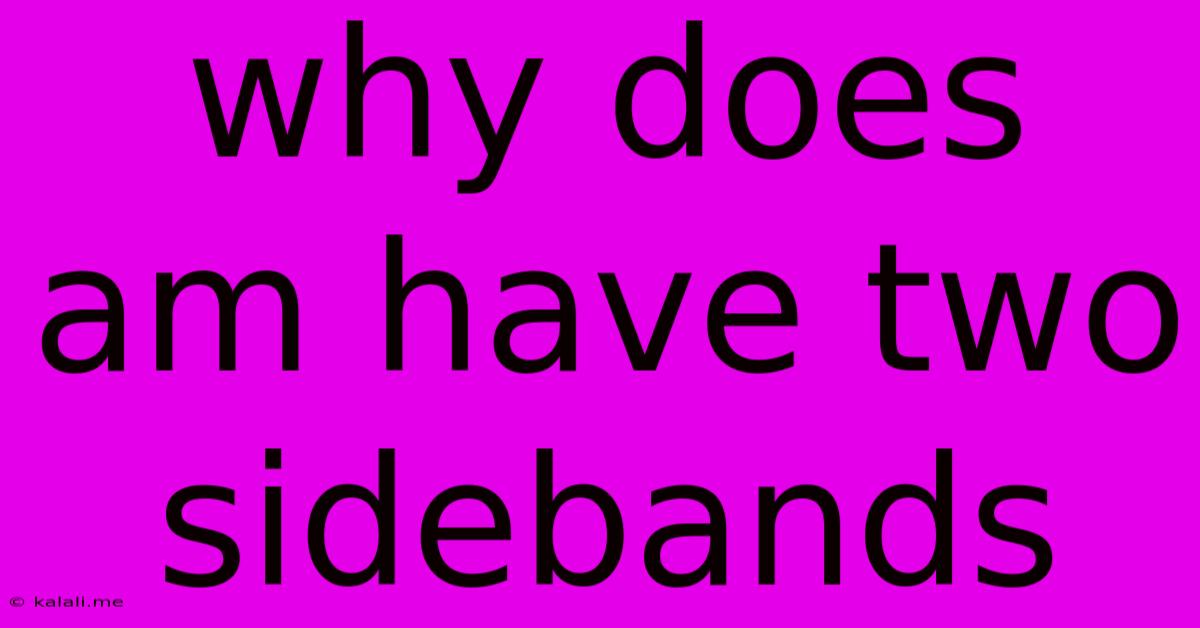Why Does Am Have Two Sidebands
Kalali
Jun 02, 2025 · 3 min read

Table of Contents
Why Does Amplitude Modulation (AM) Have Two Sidebands?
Amplitude Modulation (AM) is a widely used technique for broadcasting radio signals. Understanding why it produces two sidebands is crucial for grasping its fundamental workings. This article delves into the mathematical and practical reasons behind this phenomenon, exploring the concept of frequency spectrum and its implications for AM transmission.
Understanding the Basics of AM
In AM, the amplitude of a high-frequency carrier wave is varied in proportion to the instantaneous amplitude of the message signal (audio or data). This process creates a new signal with a wider frequency spectrum than the original carrier or message signal. This broadened spectrum is the key to understanding the presence of two sidebands.
The Mathematical Explanation: Mixing Frequencies
The mathematical representation of AM clearly reveals the two sidebands. When a message signal (let's say a simple sine wave) with frequency 'f<sub>m</sub>' modulates a carrier wave with frequency 'f<sub>c</sub>', the resulting AM signal can be expressed as:
s(t) = A<sub>c</sub>[1 + m cos(2πf<sub>m</sub>t)] cos(2πf<sub>c</sub>t)
Where:
- A<sub>c</sub> is the amplitude of the carrier wave
- m is the modulation index (a measure of the depth of modulation)
- f<sub>m</sub> is the frequency of the message signal
- f<sub>c</sub> is the frequency of the carrier wave
Using trigonometric identities, this equation can be expanded to reveal three distinct frequency components:
s(t) = A<sub>c</sub> cos(2πf<sub>c</sub>t) + (mA<sub>c</sub>/2) cos(2π(f<sub>c</sub> + f<sub>m</sub>)t) + (mA<sub>c</sub>/2) cos(2π(f<sub>c</sub> - f<sub>m</sub>)t)
This expansion shows that the AM signal consists of:
- The Carrier Wave: A<sub>c</sub> cos(2πf<sub>c</sub>t) at the original carrier frequency f<sub>c</sub>.
- The Upper Sideband (USB): (mA<sub>c</sub>/2) cos(2π(f<sub>c</sub> + f<sub>m</sub>)t) at a frequency of f<sub>c</sub> + f<sub>m</sub>.
- The Lower Sideband (LSB): (mA<sub>c</sub>/2) cos(2π(f<sub>c</sub> - f<sub>m</sub>)t) at a frequency of f<sub>c</sub> - f<sub>m</sub>.
These upper and lower sidebands contain the information from the message signal. The carrier wave itself carries no information; it's simply the "vehicle" for transporting the message.
Why Two Sidebands? Information Preservation
The presence of two sidebands is essential for complete recovery of the original message signal. Each sideband carries a different aspect of the information. Removing one sideband would result in signal distortion, and the loss of some frequency components of the original message. Both are needed for faithful reproduction of the modulated signal.
Practical Implications
The existence of two sidebands has consequences for bandwidth allocation. AM signals require a bandwidth twice the highest frequency component in the message signal. This is because the entire spectrum, including both sidebands and the carrier, needs to be transmitted. This wider bandwidth requirement is a trade-off for the relative simplicity of AM transmission and reception.
Conclusion
The generation of two sidebands in AM is a direct consequence of the mathematical process of modulating the carrier wave. These sidebands are crucial for faithful signal reproduction, and their presence necessitates a larger bandwidth compared to other modulation schemes. Understanding this fundamental characteristic of AM is essential for anyone working with radio frequency communication systems.
Latest Posts
Latest Posts
-
Unplug The Accessory Using To Much Power
Jun 04, 2025
-
Why Is It Illegal To Live In A Camp
Jun 04, 2025
-
Rose Rosette Disease Vs New Growth
Jun 04, 2025
-
Is Nick Gay In The Great Gatsby
Jun 04, 2025
-
Many Ways To Skin A Cat
Jun 04, 2025
Related Post
Thank you for visiting our website which covers about Why Does Am Have Two Sidebands . We hope the information provided has been useful to you. Feel free to contact us if you have any questions or need further assistance. See you next time and don't miss to bookmark.